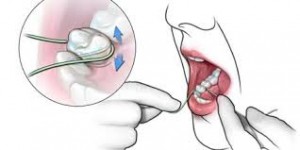It was not until about the mid 1990’s when it became apparent that gum infections and severe tooth decay could cause inflammation in the blood measurable by using the CRP marker (C-reactive protein). As this link shows Dr. Joseph Muhlestein at the University of Utah demonstrated in 1996 that chronic gum infection could cause a heart attack. He isolated the bacterium Chlamydia pneumoniae in 79% of patients undergoing coronary bypass surgery, while samples from heart transplant patients isolated this bacterium in only about 5%. The new thinking was that bugs that multiply in diseased gums could migrate into the blood and cause platelets from the blood to clump together and block coronary arteries causing heart attacks. Harvard University researchers have confirmed this. In the past it was known that a bad tonsillitis with an aggressive bacterium, Streptococcus viridans, could cause subacute endocarditis, a dangerous infectious disease of the heart valves, which can be responsible for sudden death in younger persons. Neglected cavities in teeth can also harbor this bacterium. Another study in 2009 showed that two particular strains of bacteria in infected gums, Tannerella forsynthesis and Preventella intermedia, were associated with an increased risk for heart attacks; but it was more the overall burden of bacteria in the infected gums than the specific bacteria strains that mattered most.
Preventing heart disease by brushing and flossing
With this background it is easier to understand that we need to take good care of our teeth and gums, if we want to maintain good health. As a start most people should see their dental hygienist (who usually works in a dentist’s office) twice a year. The dental hygienist will probe the depth of gingival pockets with a periodontal probe. A normal depth measures up to and including 3 mm. Deeper pockets than that usually indicate that the patient did not floss regularly. One needs to floss at least once per day, better twice per day and it should not bleed after flossing (initially when a person flosses for the first time the gums tend to bleed a bit).
The hygienist will do scaling of plaques on the tooth enamel. Any cavity that is detected will be brought to the attention of the dentist. At the end of the scaling procedure fluoride is applied, which puts a coating on the tooth surfaces to prevent tooth decay.
When deeper pockets (6 mm or more) are detected a trial of subgingival root brushings has shown to have a very beneficial result within only 14 days.
Periodontal pockets were improved and bacterial counts of periodontal infections were shown to have improved as well.
Oral care and cavity prevention in the population
It has been accepted for quite some time that a combination of brushing and flossing are the best methods to control dental plaque, which is the precursor for cavities.
In order to test the knowledge of adults in families with small children these authors from the School of Public Health of the Maryland University investigated Maryland’s adult population knowledge regarding caries prevention. It turns out that there were deficiencies in knowledge about the prevention of dental caries and the importance of fluoride to create strong, decay resistant enamel.
A randomized, prospective study is planned in Hong Kong which will start teaching oral hygiene to kindergarten children aged 3 and will be reinforced several times later to instill good dental hygiene behaviors into these children’s health routine as outlined in this link. Not only is it important to teach brushing and flossing, but also food habits with cutting down on sugary and starchy snacks as these foods make the saliva acidy promoting caries producing bacteria in the plaque.
This English study shows that a primary school based caries prevention program reduced caries by 35% when sugar intake was limited in the interventional group and brushing of teeth was done twice per day along with flossing.
An addition to flossing for those with narrow tooth intervals or those with braces is a waterpik system. This can be used to clean food residues from the spaces between your teeth and from gum pockets. Flossing once or twice per day is still needed to remove plaque to avoid tartar build-up. Before bedtime it is advisable to floss first, then use a waterpik, then use your electric toothbrush with a fluoridated toothpaste. During the day use the waterpik after meals followed by brushing with an electric toothbrush with non-fluoridated toothpaste. Water Picks are also called “water flossers”; they are easier on your gums.
Other measures helpful in preventing tooth decay
Xylitol is a natural sweetener originally derived from birch. Sugarless gum often is sweetened with Xylitol. This study has shown that chewing Xylitol containing gum can effectively reduce caries. This paper describes that the increased saliva production from chewing gum provides a slightly alkaline environment for teeth. This helps to clear out sugar faster from the oral cavity after a meal, inhibits bacterial growth, neutralizes the pH in plaque that is on the acidy side after sugar consumption. The authors concluded that chewing Xylitol gum is a useful addition to the other known preventative measures of dental decay prevention, such as brushing and flossing teeth.
The techniques the dentist is using to treat plaque and dental decay have been refined by a new technique describe in this Australian publication as a minimum intervention caries prevention program.
The four methods used in minimum intervention dentistry are described here.
1. Recognition: to recognize potential caries factors early through lifestyle factor analysis and saliva testing.
2. Reduction: alter the diet and lifestyles to increase the pH of the saliva, which will reduce the risk factors for caries.
3. Regeneration: to arrest and reverse minimum lesions at the earliest stage. Use agents such as fluorides and casein phosphopeptides-amorphous calcium phosphates to achieve this.
4. Repair: when a cavity is present, a technique of “conservative caries removal” involves using bioactive materials to allow healing of the dentine layer of the tooth.
Reduction of cariogenic bacteria
I already mentioned above that alkalization of saliva by chewing Xylitol gum could significantly help prevent tooth decay. It does so by raising the pH, while chewing on sugary foods or starchy foods lowers the pH (making it more acidy). Growth of caries producing bacteria, which are called “cariogenic bacteria” is stimulated by acidy saliva and inhibited by alkaline saliva. For this reason people whose diet consists of a lot of vegetables and greens will have more alkaline saliva and are less prone to develop cavities. The worst foods to get cavities are sugar in its many disguises and starchy products (candies, bread, rice, potatoes, pasta, bagels, cookies, cakes).
What can cause bacteria from the mouth to appear in the blood? One common condition is periodontitis, which is a chronic inflammatory condition of pockets of the gums around the teeth. This originates from neglecting your teeth and not flossing. Smokers are more afflicted by this as well. Dental procedures called scaling and root planing are often done for chronic periodontitis. This study from January 2013 shows that there is about the same amount of bacteria that leak into the blood following these procedures when compared to flossing.
Sometimes a dentist will recommend using a short-term antibiotic to reduce the leakage of bacteria into the blood, particularly with people who have heart valve problems or had porcine heart valve replacement in the past. This publication from 2009 also describes that dental flossing causes bacteria to be shed into the blood (bacteremia).
Conclusion
Dental self-care should be taught to children at an early age to educate them to brush their teeth twice a day and floss them at least once per day. At the same time they need education what causes cavities in terms of food intake and that fluoride can help make teeth more cavity resistant. They should avoid sugar in pop, candies and cookies etc. Parents best teach by example! Regular visits to the dentist’s office will safe money on the long term. Regular scaling by a dental hygienist every 6-month will remove plaque from which cavities develop when bacteria thrive in them and produce acids that affects the enamel. Minimum intervention dentistry discussed above (4 methods used) can prevent your teeth from decaying. Regular flossing will keep your gums healthy and reduce the colonization of the mouth with bad, cariogenic bacteria. With all this in place you likely will keep your teeth for a long time and not need dentures or tooth implants because of lost teeth. At the same time you will prevent your immune system being overwhelmed by mouth bacteria, which could have lead to a heart attack had you neglected your teeth. As mentioned in the beginning, a CRP blood test is a useful tool to rule out chronic infection.
More information on:
1. Tooth decay: http://www.nethealthbook.com/articles/dentistry.php#Tooth_Decay
2. Heart attacks: http://nethealthbook.com/cardiovascular-disease/heart-disease/heart-attack-myocardial-infarction-or-mi/
Reference: http://www.webmd.com/heart-disease/features/your-guide-gum-disease
Last edited Nov. 7, 2014







